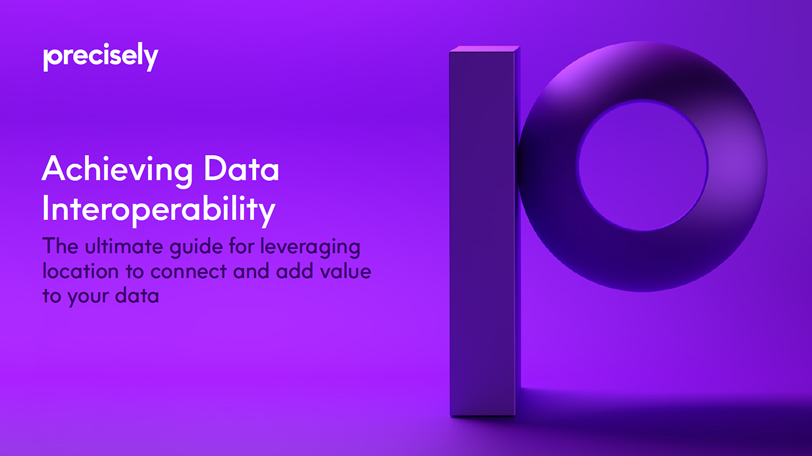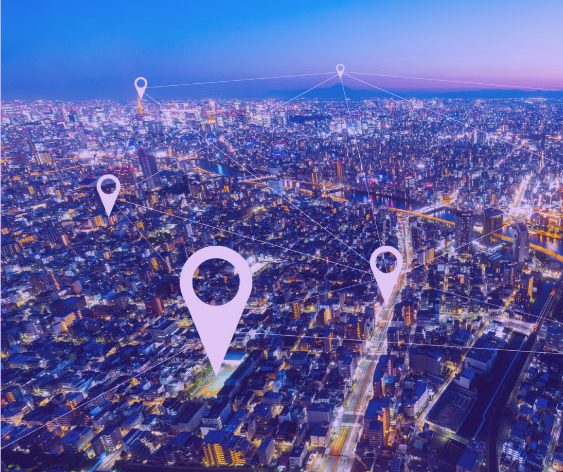eBook
Achieving Data Interoperability
Read this eBook to see how Precisely helps businesses manage and organize data and bring greater location context to their analysis to answer the biggest challenges around data.
The ultimate guide for leveraging location to connect and add value to your data to achieve data interoperability
The World Economic Forum estimates there were 44 zettabytes of data collected in 2020. That’s 1,000,000,000,000,000,000,000 bytes of data, which is 40 times more bytes in the digital universe than there are stars in the observable universe. If knowledge is power, imagine the potential in those bytes. However, just because data is everywhere doesn’t mean it’s easy to use. For businesses, the challenge is linking data, connecting it to where the market wants to go, and making it useable within the applications they’re using.
To survive, compete, and thrive in the modern business landscape, businesses must be able to harness the growing utility of data. However, acquiring, integrating, storing, processing, and using the explosion of data is an ever-growing challenge. Fragmented data and systems, a mix of specialists and business users, and different environments are among the obstacles to sharing, integrating, and working with the enormous wealth of data in the digital age. What’s more, there an urgency to tap the potential value of existing data. Data interoperability is the key to harnessing the transformative power of data.


What is data interoperability?
Interoperability is ability for things to work together. So, data interoperability then, is the process of making data compatible. Sounds simple, but in actuality it’s extremely difficult. Enterprise data users must have a common understanding of how data is structured to effectively exchange it across systems. They must also share a common understanding of how the various components of a dataset relate to both each other and to the components of other datasets.
Many companies try to tackle this problem by attempting to get a handle on their data across various organizational silos. Some assign IT the task of organizing and managing all this information. Others have everything from enterprise architecture to data acquisition and data modeling to data governance covered in various departments. As these disparate groups each tackle their own initiatives, with different ways of bringing in, managing, and processing that data, their decentralized repositories of data and inconsistent processes just lead to additional challenges. In working so hard to handle their data what many miss, is a meaningful approach to how to connect their data. A straight-forward way to organize, manage, and enrich to inform decisions – accurately.
Leveraging location to solve your data problem
Luckily, there’s a group of business leaders doing things differently and paving the way for companies interested in making enterprise wide data interoperability a business priority. This capability is made possible by an increasingly powerful tool they are already leveraging in some capacity: Location. Location can be used as a tool that leverages the most common and usable piece of information – an address – to connect the dots. Business visionaries are realizing that location can be the common thread to not only connecting disparate data sources and breaking down those silos – but one that provides some of the most valuable and transformative insights.
Knowing where things happen is a superpower. The ability to understand things like where your assets are located, where cellular coverage is poor, where emergency resources are best deployed, where crime is high, and where demand is coming from are all examples of fundamental ‘location’ based questions that require accurate answers.
Every meaningful thing on Earth exists in an actual location. If we believe that, if we really believe it – then isn’t it arguable that every aspect of driving business success and getting return on investment is “location” dependent? With that in mind, as companies are struggling with complexity and complication of data – location is the one tool in reach that can help bring order. Unfortunately addresses alone aren’t the answer.
The risk of using addresses alone to connect information
An address is one of the most important and relied upon pieces of business information. Yet, in most parts of the world, including the US and Europe, addresses were developed and used long before computers attempted to read and process them. They are inconsistent and complex.
Too frequently, addresses are utilized as a simple identifier for a building or location. This ID is then used to link and enrich that information. An address however should not be used as an identifier, because it is a complex multi-field labeling system that frequently changes. Multinational organizations that use address data as a primary way to link and manage data face increased challenges because of the varied and complex addressing rules across the globe and the high error rate.

In some countries physical addresses and postal codes may not even exist, other countries don’t follow the concept of continuous house numbers. The list of addressing “exceptions” across the globe is long. Despite our incredible digital advances as a society, in most cases there is still an actual person required to help interpret a written address to insure a person a place or a thing is linked to the correct address.
The human eye for example, can discern that 123 Mian ST, Anytown OH, 08543 and 123 Main Street, Anitown OH, 08543 are the same. Yet, to a computer this isn’t a 1:1 match. Many operations would fail because of this input.
Imagine if you were using that bad address to connect and manage all your data in pursuit of data interoperability. If your goal is to improve the quality of your insights and create more meaningful outcomes and analysis you can’t build off a foundation that starts with a bad address.
Now, correcting an address matching error like this doesn’t take much time if you have specialized geolocation software to help you do it and if you’re only correcting a small number of addresses. Instead, imagine a client that processes and therefore must verify hundreds of thousands of addresses per day. It’s a far more complex and resource-heavy process.
Furthermore, while a physical address is of paramount importance for postal delivery purposes, it does not tell you where that address is located relative to other locations, such as a sales territory, flood plain. specific tax district— or distance to the nearest business. Spatial analysis serves as a basis for critical business decisions in marketing, operations, and a wide variety of industries such as insurance, telecommunications, and the public sector. But, before you can use an address to connect and manage your data let alone use it analyze, extrapolate, or profit from; you first need a way to associate each record with an accurate latitude and longitude coordinate—that’s a process known as geocoding.

Everything you need to know about geocoding
Most people understand the importance of using a standardized and quality address. But what they might not know is that a proper geocode is the foundational starting point for high-quality data management and data interoperability.
Geocoding is the process of converting text-based data about a location, such as the address or name of a building, and assigning it latitude and longitude, a spatial representation in numerical coordinates that makes it easier to analyze data. Oppositely, reverse geocoding is the process of converting geographic coordinates into a readable address. Geocoding is important because it can be used by every business to prepare their data for location-based analysis.
Some people think of geocoding only in the context of maps, but geocoding is also the enabling technology for spatial analysis that makes it possible for organizations to identify and understand the relationships between two or more locations.
Let’s explore a few examples:
Better understand where your customers are located
Geocodes help businesses map coverage, customers, and competitors to determine prime target areas for promotional activities and ensure that offers align with available services.
Optimize site selection
With geocoding, it is easy to map current and competitive retail locations, and match these against demographics for a clear indication of challenges and opportunities.
Plan for and mitigate risk
From fault lines to shorelines, knowing precise proximity to potential hazards helps ensure smart infrastructure placements.
It’s important to note that the geographic coordinates representing locations often vary greatly in positional accuracy, so understanding your error tolerance for the business problem you are trying to solve is key to selecting the right geocoder for your needs.
A geocoder is made of two critical components: a reference dataset and a geocoding algorithm. Without understanding how these geocoding processes work, it is difficult to make informed business decisions based on geocoding. In fact, with so many factors affecting the geocoding process, assessing geocoding solutions can be overwhelming.
To help, here are five categories of geocoder capabilities that should be consider when looking for a geocoding solution as part of your overall data interoperability strategy.
1. Matching
The interpretation of an input address and matching it to reference data.
2. Positional accuracy
How close the geocode is to the specific addressable location you are targeting.
3. Throughput
How many records per unit of time the geocoder can process.
4. Metadata
The data you have about your geocoding results, which enables operational automation and insights.
5. Deployment options
Where will the geocoder reside? On what platform will it run? How will it integrate?
Geocoding and data interoperability:
An accurate match made in heaven
What does Geocoding have to do with Data Interoperability? It enables context through the process of geo-enrichment, allowing a business to focus on the importance of a customer address or location.
With accurate latitude and longitude coordinates, organizations can calculate the distance between two points, the distance to a specific boundary and determine if an address is situated within a zone or territory. Unfortunately, most databases do not contain geocodes as part of the associated address data. When they do, there may be a high degree of uncertainty in the quality of those geocodes, which can lead to faulty business decisions and costly mistakes. On aggregate, these mistakes can lead to lawsuits, attrition, and significant losses.


Earlier we discussed that data interoperability is the process of making data compatible. To do those businesses, require a straight-forward way to organize and manage their data. We also learned that many do that by utilizing and address to connect all their disparate data without If your goal is to improve the quality of your insights and create more meaningful outcomes and analysis you don’t want build on a foundation that starts with a bad address.
Today, geographic-based insights drive everything from social policy, network planning to market analysis. In business, they are essential for risk management, regulatory compliance, pricing, and strategic planning. That’s why so many organizations employ geocoding. Geocodes translate common reference points, such as customer addresses, into latitude and longitude coordinates that makes it easier to analyze data. It helps you validate and cleanse and standardize your database to build trusted data and ensure accuracy through the business process and across the enterprise.
Beyond geocoding: The PreciselyID
We’ve learned that Geocoding is the process of taking text-based data about a location, such as the address or name of a building, and assigning geographic coordinates such as latitude and longitude. Yet, geocoding is insignificant without the other data available about that location. For example, you may geocode a building but not a specific office within that building. There are thousands of data points available and relevant to specific geolocations, such as legal land use parcel, building footprint, building attributes, demographics, socio-economic factors, and more. Businesses need to know how to link those thousands of attributes together, so the data becomes meaningful.
Precisely developed the PreciselyID to solve this problem. Our team is doing the work of pre-processing all known addresses in a country and attaching a unique and persistent ID to it. This ID, the PreciselyID is a unique and persistent identifier that can incorporate thousands of attributes to enrich one location. Using this ID, allows companies to easily correct and process records in bulk and keep them up to date. It also enables users of that PreciselyID to connect an address to other property or location data to provide a composite view of an address that can be utilized in a variety of use cases, all without spatial processing. This not only saves customers processing time and expense but increases overall data value and correctness while extending this information to a superset of business users. These users may not have GIS backgrounds but require the information it provides. The PreciselyID enables companies to understand and organize data in a way that moves them to contextualized knowledge, automation, and better decision-making at all levels and at scale.
“This not only saves customers processing time and expense but increases overall data value and correctness while extending this information to a superset of business users.”
The unique and persistent nature of the PreciselyID facilitates seamless data interoperability for data enrichment. Joining different datasets together with the PreciselyID field empowers you to analyze an address from multiple perspectives and eliminates time-consuming spatial processing. For example, the Precisely ID can be linked to other feature IDs that are useful for functions such as:
- Mortgage underwriting
- Tax information
- Real estate transactions
- Social networking
- Reverse geocoding
- Retail site selection
- Construction
- Marketing
- Persona selection
Appended to millions of pre-processed data points, the PreciselyID links an address to points of interest, property, demographic, and boundary datasets. Performing a quick and simple lookup of a PreciselyID returns a wealth of information related to that specific geocoded point such as:
- Risk of fire, flood, high winds, and other weather and natural phenomenon
- Demographic information such as income
- Social information such as school districts and neighborhoods
- Property data such as assessed value, building materials used, and more
- Location intelligence combinations such as nearest + distance to + is within = X.
PreciselyIDs also give businesses new ways of looking at their data and transform a static photo into actionable data. For example, by transforming environmental data related to a weather event, such as the predicted path of a tropical storm, an organization can more accurately understand which parts of their business, or their clients will be impacted at the core and the periphery. Using that data, they can make faster and more accurate decisions about improving processes, deploying resources, or detecting fraud.Linking the information from one data product to another reduces matching complexity and increases data confidence for decision making. The result is the ability to deploy more efficient business processes, avoid large-scale processing and uncertainty, link addresses, locations, and enrichment data across business systems for data interoperability that allows you to tap the maximum potential of the data in your systems.

Closing thoughts
Looking at some of the data mistakes that have been made in the world – experience really counts. Data overload is a real thing. Data is everywhere and it is messy. This problem is not sexy, but boy is it big.
Precisely helps businesses manage and organize data and bring greater location context to their analysis. Answers to the biggest challenges around data are all pillars of Precisely’s strategic approach to deliver data and location excellence to our customers. That begins and ends with using accurate location as a tool and a connection point to achieve data interoperability and comprehend and translate the complexity of our world through accurate location.

